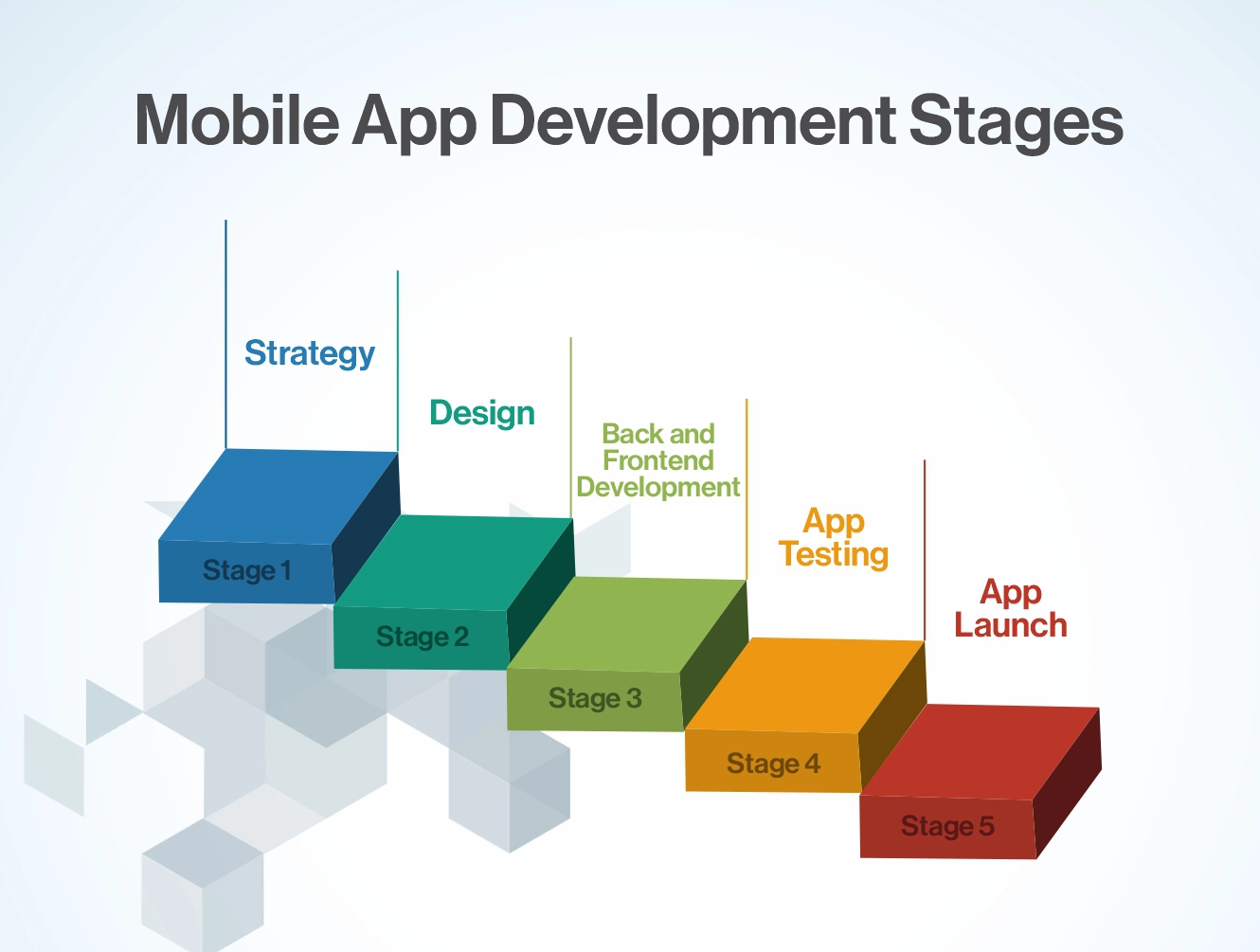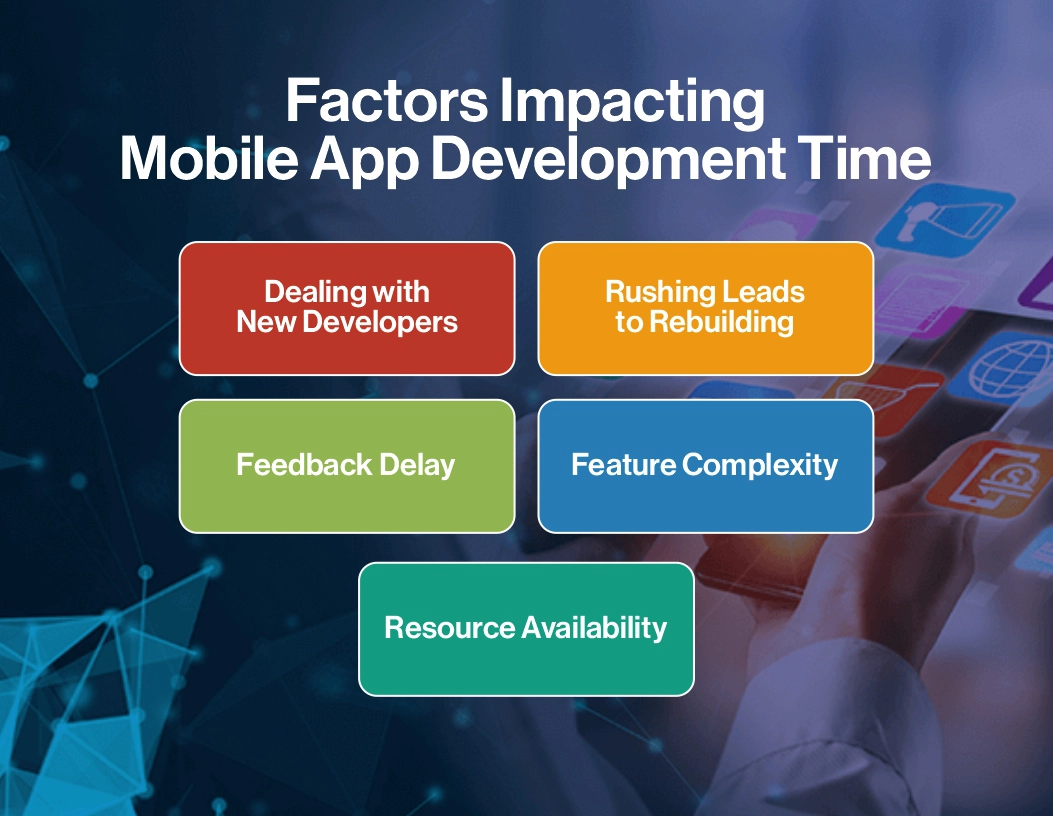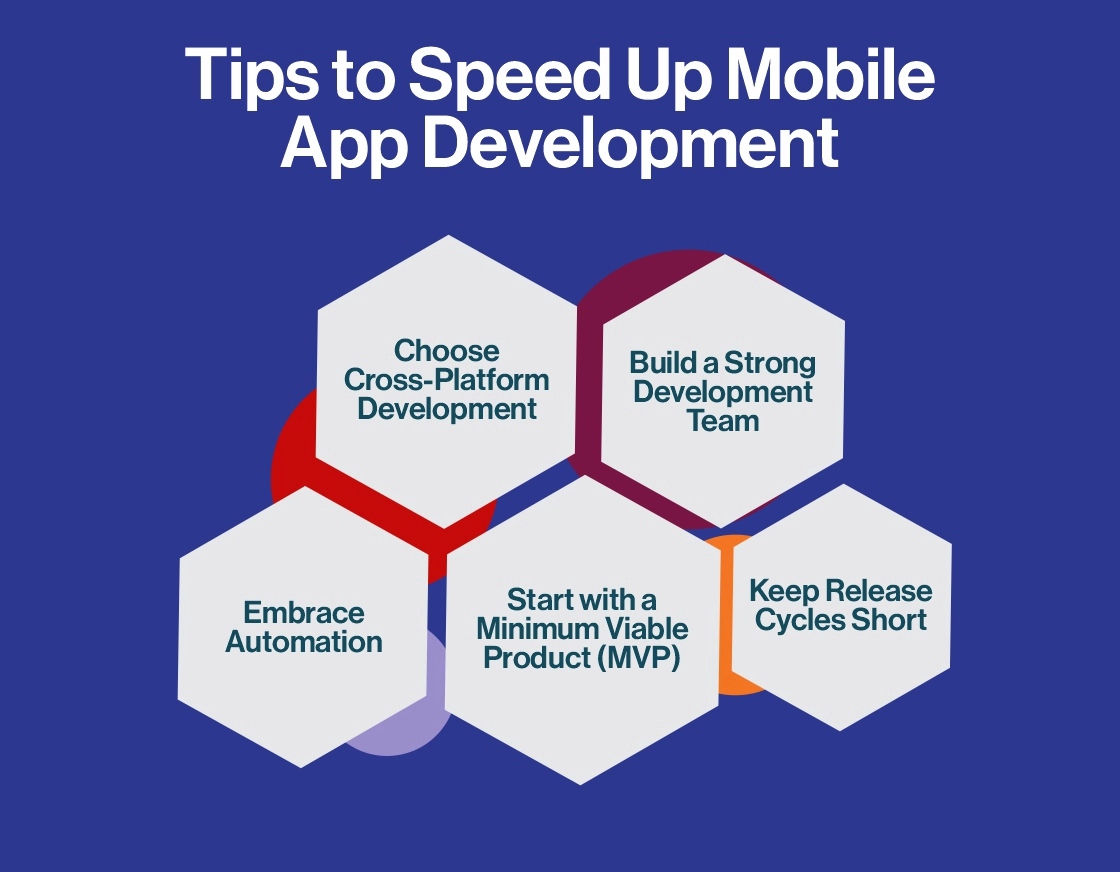The digital landscape has been shaped by the consistent increase in mobile app development in recent years. These applications are made for cellphones and work with iOS and Android operating systems. They offer a richer experience than browsing the web on mobile.
With over 78% of people worldwide using smartphones, apps have become integral to daily life. They span various categories, such as gaming, music, calendars, and social media, with popular ones like WhatsApp, Spotify, and Instagram.
Creating an app can be a smart business move, but it's crucial to understand the mobile app development stages. In this blog, we’ll discuss these stages. So, let’s get started!
Key Takeaways:
- Agile emphasizes adaptability and customer collaboration, crucial for mobile app success
- Strategy, Design, Development, Testing, and Launch are the key stages
- Define goals, understand the audience, analyze competitors, and choose a platform
- Clarify requirements, plan UX, create UI design, and maintain support
- Frontend focuses on user interface, backend deals with data integration and logic
- Crucial for ensuring functionality, involves alpha and beta testing, and fixing issues
- Optimize app stores, add final touches, and ensure readiness before launching
- Newbie developers, rushing, feedback delays, feature complexity, and resource availability impact development time
- Choose cross-platform development, build a strong team, embrace automation, keep release cycles short, and start with MVP
What is Mobile App Development?
Mobile app development is the process of developing software specifically for tablets, smartphones, and other mobile devices. This entails producing code and designing the user interface for the program.
While it shares similarities with other forms of software development, such as web apps, mobile app development stands out due to its ability to tap into the native features of a device. This means apps can utilize functions like GPS, Bluetooth, cameras, microphones, and more, which are built into smartphones.
Apple's iOS and Google's Android platforms hold a significant market share in the worldwide mobile application industry. While apps can be created for other platforms, most developers target these two major markets. Various app development frameworks exist, offering developers a range of options.
Understanding the Agile Approach
Developing mobile apps isn't a one-shot deal. Project management is crucial, dividing app building into manageable steps and overseeing every aspect to ensure top-notch quality. Thankfully, Agile development, a methodology within the Software Development Life Cycle (SDLC), revolutionized software development teams.
Agile methodology within SDLC sequences phases from project initiation to completion. Each phase comprises activities, ensuring specific deliverables. Agile emphasizes agility and adaptability, which are crucial for projects with evolving requirements. It operates on iterative delivery and incremental development. Embracing Agile means adhering to key principles in mobile app development:
- Prioritize functional software above copious documentation.
- Prioritize customer cooperation over formal contracts.
- Adapt to change rather than following a set strategy to the letter.
Key stakeholders in Agile include the Product Owner, Development Team, Project Manager, and Project Sponsors.
Other methodologies within SDLC encompass Continuous Integration, Incremental Development, Rapid Application Development, Spiral Development, and Waterfall Development.
Mobile App Development Stages

Stage 1: Strategy
The important strategy formulation stage occurs at the onset of the application development lifecycle. This phase involves complete planning, defining the app's purpose, identifying its target audience, selecting appropriate technologies, and establishing metrics for measuring success.
Define the Mobile App's Goals and Objectives
The foundation of a successful mobile app rests on its ability to effectively address user needs. Identifying the specific problems your app intends to solve and outlining how users will benefit from its functionalities is crucial.
Profile the Target Audience
Conduct thorough research to understand your app's potential users' demographics, motivations, behavior patterns, and goals. Whether they use iPhones or Android devices, it's essential to grasp their characteristics throughout the user lifecycle. This enables the creation of detailed user personas, aiding in comprehending users' genuine needs and limitations. Understanding your users is fundamental to the development of an effective mobile app. Comprehensive research provides clarity and establishes a solid foundation for your app's direction.
Analyze Competitors
Conducting a thorough examination of your competitors' apps is crucial. This analysis helps identify missing features in their apps, which you can leverage to differentiate and enhance your own app.
Choose a Mobile Platform
Once you've identified your target audience, deciding on the preferred mobile platform, iOS or Android, is essential. There are two primary development approaches:
a. Native Development
If you want to create a high-performance program with intricate features and a smooth user interface, go with native development. In the future, native apps may be readily upgraded and expanded with new features.
b. Cross-Platform Development
Consider cross-platform development if you have a tight timeline to test your app idea in the market or require your app to function across multiple operating systems. You can create a single app for both the iOS and Android platforms using this method, which also makes it more affordable.Ty
Output of the Strategy Stage
Clarity on the App's Goals and Target Audience
Through comprehensive analysis and research, understand the objectives your app aims to achieve and the audience it intends to serve.
Selection of the Preferred Mobile Platform
Decide whether to pursue native or cross-platform development based on performance requirements, user experience goals, and budget considerations.
Creation of a Project Roadmap
Develop a detailed project roadmap outlining the key milestones, timelines, and resources required for app development. Incorporate technical considerations based on desired functionalities to ensure smooth project execution.
Stage 2: Design
In the Design stage, assembling a proficient development team is paramount. A product owner, project manager, business analyst, two to three app developers for each platform (iOS and Android), a back-end developer, a UI/UX designer, and one or two QA engineers often make up this team. After assembling the team, the design phase may start.
Clarifying Requirements
The team initiates by scrutinizing the project's initial data. Subsequently, they engage in a workshop with the client to delve deeper into specific and contextual questions. It's critical that all project participants work together to comprehend the requirements.
UX Planning
The team creates the app's architecture to enhance conceptual understanding during this stage. It prepares a detailed prototype for the future mobile app, encompassing every aspect, from buttons to pop-ups and text fields.
The team meticulously analyzes and categorizes all the client's information, addressing any gaps in understanding. They commence structuring the project, delineating user flows, identifying happy paths, and addressing edge cases. Following the NDA agreement with the client, the team progresses to the next stage, UI design.
UI Creation and Design
In this stage, while considering the client's preferences, the primary focus shifts to aligning the design with the preferences and needs of the target audience. Upon obtaining approval for the main screens' designs, the team develops the project's style guide and completes the remaining screens. If the client has a brand book or specific corporate style, adhering to it meticulously is imperative, ensuring consistency and cohesion throughout the app's design.
Maintenance and Testing
The designer's work goes beyond just creating the prototypes once mobile app developers have access to them all. They continue collaborating with the project team during the development stage, elucidating intricate logic and structural elements while seeking a balance between aesthetic appeal and technical feasibility. Moreover, the designer assumes responsibility for verifying the final product's adherence to its design and conceptual framework.
Through these collaborative efforts, the team ensures the creation of a high-quality, customized app tailored to achieve the customer's business objectives and resonate with the target audience's goals.
Output of the Design Stage
UI/UX Final Blueprint for Development
The selected format (source design files, project specification for developers in programs like Zeplin, Adobe XD, Figma, and InVision) should contain wireframes, concepts, prototypes, and user testing findings.
Style Guide
Specification lists fonts, sizes, element styles, and states to preserve uniformity throughout the application.
Clickable Prototype and/or Application Scheme (Optional)
Provided if requested by the client to visualize app interactions and flow.
Continued Support from the Development Team
Ongoing assistance and collaboration from the development team are needed to ensure the seamless implementation of design elements into the final product.
Stage 3: Back and Frontend Development
During this stage of mobile app development, two sets of developers are required: one for front-end development and another for back-end development.
- Front-end developers focus on translating the user interface design into code, ensuring a seamless user experience.
- The back-end development team is responsible for coding data integration, server logic, app server setup, user management, and database implementation.
Programming languages including CSS, Python, HTML, and Java are used by backend developers to build the functionality of the app.
Planning remains crucial throughout this process, with three main components: frontend and Backend development and User Interface design. The duration of this development stage hinges on several factors, including app complexity, integration processes, architectural setup, and chosen technology stack.
Also, the platform chosen for app development can impact the timeline. iOS app development typically progresses faster than Android due to differences in development processes and tooling.
Stage 4: App Testing
In app development, testing is important. It's like checking to ensure everything works well before showing it to everyone. After developing an app, the next big thing is ensuring it works right.
During testing, if there are any problems with the app, find them and send them back to the people who made it to fix them. Testing should take about 3 to 4 weeks. First, test it yourself (alpha testing). Then, let some users try it out (beta testing).
These tests help us determine if the app is good enough and can handle many users at once. We also check that it runs smoothly and doesn't break.
After beta testing, listen to what users say about the app and, depending on their feedback, make changes to improve it. Also, do lots of tests, like fixing any problems, making sure different parts of the app work together, checking if everything does what it's supposed to, and seeing if people find it easy to use.
Always test the app on different devices to see how it works for everyone. Make sure to address any bugs before making the app available to all users. Testing might seem like a lot of work, but ensuring our app is the best it can be is super important!
Stage 5: App Launch
After all the hard work you put into creating your app, the last big step is launching it on mobile app stores like the App Store and Google Play Store.
Before you hit the launch button, there are some important things to do. You need to think about stuff like making sure your app shows up well in app store searches (SEO) and adding cool stuff to make your app interesting for different people.
Even though you've been getting ready for a while, there are always some last-minute things to do. So, it might take about 1 to 2 weeks to ensure everything's just right before you launch.
When you finally launch your app, you've already finished making it and fixing any problems that came up during testing. You’ve covered all the main stages of making an app by reaching this final step. Understanding these steps helps you see what an app takes to succeed.
You can't speed up the process of creating a mobile app. It takes a lot of time to get everything right, including building the software, designing the app, adding features, and more. Many things can make the process longer, especially if your app is complicated. But in the end, doing it well is what makes your mobile app unique.
Factors Impacting Mobile App Development Time
Several factors can affect how long it takes to develop a mobile app. Let's break down each factor that might slow down your app development journey:

Dealing with New Developers
Hiring inexperienced app developers can significantly extend your project timeline. While a typical mobile app project might take 6 to 9 months, having a green team onboard can drag this out further, causing delays and potentially more headaches.
Rushing Leads to Rebuilding
Trying to rush through the development process can lead to more time spent fixing mistakes. Taking your time during development can help you avoid costly errors that could extend the timeline.
Feedback Delay
Waiting for feedback from stakeholders can be a major roadblock. Developers often receive feedback after everything's already been built, forcing them to backtrack and make changes, which can consume precious time.
Feature Complexity
The more features your software has, the more work it will take to build. Integrating functionalities like payment systems can add months to the timeline, while simpler apps like data-gathering tools may be quicker to build.
Resource Availability
Limited resources like a small development team can stretch your timeline. To speed things up, you must ensure you have enough skilled developers on board who understand the mobile app landscape.
Tips to Speed Up Mobile App Development
If you're looking to fast-track your mobile app development journey, here are some handy tips and tricks to help you out:

Choose Cross-Platform Development
Choose cross-platform or hybrid app development instead of developing separate apps for different platforms. This approach allows you to share code between platforms, cutting development time and costs in half while providing a decent user experience.
Build a Strong Development Team
Invest in assembling a knowledgeable in-house app development team. While it may seem daunting initially, having the right team onboard can lead to high-quality development completed within the estimated timeline or even earlier.
Embrace Automation
Throughout the development process, automate time-consuming procedures to maintain consistency and save time.
Keep Release Cycles Short
It is advisable to break down your app's features into smaller parts and gradually release them to speed up the development process.
Start with a Minimum Viable Product (MVP)
Don't try to pack every possible feature into your app from the get-go. Rather, concentrate on releasing a minimal viable product (MVP) that has the most important features so that you can measure customer interest and get feedback. Based on user feedback, you can then modify and enhance your app to make sure it satisfies changing requirements and standards.
Conclusion
Developing a mobile app is no small task. It takes time and dedication before it's ready for download in the app stores.
The key to success is effectively implementing what was planned during the development phase. Just like any other software, app development is an ongoing journey. It's not just about launching the app; it's about continually innovating and improving to keep users engaged and satisfied.
Investing in app development requires careful planning and execution. It's not something to be taken lightly. Proper planning is essential to staying on track, cutting costs, and progressing efficiently.
So, why choose FiveRivers Technologies for your mobile app development needs? Our team has experts in various business domains, ensuring we meet your unique requirements. We collaborate with you every step of the process to guarantee a good solution, whether you require a little adjustment or a whole overhaul!
FAQs
What are the Three Main Stages of App Development?
The three main stages of app development are:
- Strategy
- UI/UX Design
- Front and Back End Development
What is App Lifecycle?
An application development lifecycle refers to the various stages an application goes through from its launch to its termination. These stages typically include initialization, execution, background processing, suspension, and termination. Understanding the app lifecycle is crucial for developers to manage resources efficiently and provide a smooth user experience.

